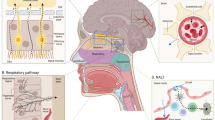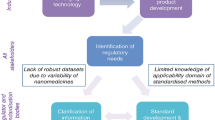Abstract
This study describes the potential of solid lipid nanoparticles and nanostructured lipid carriers as nano-formulations to administer to the central nervous system poorly water soluble drugs. Different neuroactive drugs, i.e. dimethylfumarate, retinyl palmitate, progesterone and the endocannabinoid hydrolysis inhibitor URB597 have been studied. Lipid nanoparticles constituted of tristearin or tristearin in association with gliceryl monoolein were produced. The nanoencapsulation strategy allowed to obtain biocompatible and non-toxic vehicles, able to increase the solubility of the considered neuroactive drugs. To improve URB597 targeting to the brain, stealth nanoparticles were produced modifying the SLN surface with polysorbate 80. A behavioural study was conducted in rats to test the ability of SLN containing URB597 given by intranasal administration to alter behaviours relevant to psychiatric disorders. URB597 maintained its activity after nanoencapsulation, suggesting the possibility to propose this kind of vehicle as alternative to unphysiological mixtures usually employed for animal and clinical studies.








Similar content being viewed by others
Abbreviations
- CNS:
-
Central nervous system
- SLN:
-
solid lipid nanoparticles
- NLC:
-
nanostructured lipid carriers
- DMF:
-
dimethyl fumarate
- RP:
-
retinyl palmitate
- PRG:
-
progesterone
- P80:
-
polysorbate 80
- cryo-TEM:
-
cryogenic transmission electron microscopy
- PCS:
-
photon correlation spectroscopy
- EE:
-
encapsulation efficiency
- LC:
-
loading capacity
- PTSD:
-
post-traumatic stress disorder
References
E.J.M. Achterberg, V. Trezza, L.J.M.J. Vanderschuren, Glucocorticoid receptor antagonism disrupts reconsolidation of social reward-related memories in rats. Behav. Pharmacol. 2(216–225) (2014)
A. Ambruosi, H. Yamamoto, J. Kreuter, Body distribution of polysorbate-80 and doxorubicin-loaded [14C]poly(butyl cyanoacrylate) nanoparticles after i.v. administration in rats. J. Drug Target 13, 535–542 (2005)
M.L. Amin, P-glycoprotein inhibition for optimal drug delivery. Drug Target Insights 7, 27–34 (2013)
W.A. Banks, Characteristics of compounds that cross the blood-brain barrier. BMC Neurology 9(Suppl 1), S3 (2009)
R. Bomprezzi, Dimethyl fumarate in the treatment of relapsing–remitting multiple sclerosis: An overview. Ther. Adv. Neurol. Disord. 8, 20–30 (2015)
Cosmetic Ingredient Review Expert Panel, Final report of the safety assessment of alcohol denat., including SD Alcohol 3-A, SD Alcohol 30, SD Alcohol 39, SD Alcohol 39-B, SD Alcohol 39-C, SD Alcohol 40, SD Alcohol 40-B, and SD Alcohol 40-C, and the Denaturants, Quassin, Brucine Sulfate/Brucine, and Denatonium Benzoate. Int. J. Toxicol 27, 1–43 (2008)
E. Esposito, M. Fantin, M. Marti, M. Drechsler, L. Paccamiccio, P. Mariani, E. Sivieri, F. Lain, E. Menegatti, M. Morari, R. Cortesi, Solid lipid nanoparticles as delivery systems for bromocriptine. Pharm. Res. 25, 1521–1530 (2008)
E. Esposito, P. Mariani, L. Ravani, C. Contado, M. Volta, Simone Bido, M. Drechsler, S. Mazzoni, E. Menegatti, M. Morari, R. Cortesi, Nanoparticulate lipid dispersions for bromocriptine delivery: Characterization and in vivo study. Eur. J. Pharm. Biopharm. 80, 306–314 (2012)
E. Esposito, L. Ravani, M. Drechsler, P. Mariani, C. Contado, J. Ruokolainen, P. Ratano, P. Campolongo, V. Trezza, C. Nastruzzi, R. Cortesi, Cannabinoid antagonist in nanostructured lipid carriers (NLC): Design, characterization and in vivo study. Mat. Sci. Eng. C 48, 328–336 (2015)
E. Esposito, M. Drechsler, R. Cortesi, C. Nastruzzi, Encapsulation of cannabinoid drugs in nanostructured lipid carriers. Eur. J. Pharm. Biopharm. 102, 87–91 (2016)
T.M. Göppert, R.H. Müller, Polysorbate-stabilized solid lipid nanoparticles as colloidal carriers for intravenous targeting of drugs to the brain: Comparison of plasma protein adsorption patterns. J. Drug Target. 13, 179–187 (2005)
V. Jenning, A.F. Thunemann, S.H. Gohla, Characterisation of a novel solid lipid nanoparticle carrier system based on binary mixtures of liquid and solid lipids. Int. J. Pharm. 199, 167–177 (2000)
K. Jores, W. Mehnert, M. Drechsler, H. Bunjes, C. Johann, K. Maeder, Investigations on the structure of solid lipid nanoparticles (SLN) and oil-loaded solid lipid nanoparticles by photon correlation spectroscopy, field-flow fractionation and transmission electron microscopy. J. Control. Release 95, 217–227 (2004)
M.D. Joshi, R.H. Müller, Lipid nanoparticles for parenteral delivery of actives. Eur. J. Pharm. Biopharm. 71, 161–172 (2009)
Y. Kawabata, K. Wada, M. Nakatani, S. Yamada, S. Onoue, Formulation design for poorly water-soluble drugs based on biopharmaceutics classification system: Basic approaches and practical applications. Int. J. Pharm. 420, 1–10 (2011)
R.A. Linker, R. Gold, Dimethyl fumarate for treatment of multiple sclerosis: Mechanism of action, effectiveness and side effects. Curr. Neurol. Neurosci. Rep. 13, 394 (2013)
Y. Liu, J. Qiu, Z. Wang, W. You, L. Wu, C. Ji, G. Chen, Dimethylfumarate alleviates early brain injury and secondary cognitive deficits after experimental subarachnoid hemorrhage via activation of Keap1-Nrf2-ARE system. J. Neurosurg. 123, 915–923 (2015)
V. Luzzati, H. Delacroix, T. Gulik-Krzywicki, P. Mariani, R. Vargas, The cubic phases of lipids. Curr. Top. Membr. 44, 3–24 (1997)
M. Maden, Retinoic acid in the development, regeneration and maintenance of the nervous system. Nat. Rev. Neurosci. 8, 755–765 (2007)
A. Manduca, M. Servadio, P. Campolongo, M. Palmery, L. Trabace, L.J. Vanderschuren, V. Cuomo, V. Trezza, Strain- and context-dependent effects of the anandamide hydrolysis inhibitor URB597 on social behavior in rats. Eur. Neuropsychopharmacol. 24, 1337–1348 (2014)
A.A. Martinez, M.G. Morgese, A. Pisanu, T. Macheda, M.A. Paquette, A.T. Seillier, Activation of PPAR gamma receptors reduces levodopa-induced dyskinesias in 6-OH DA-lesioned rats. Neurobiol. Dis. 74, 295–304 (2015)
E. Merisko-Liversidge, G.G. Liversidge, Nanosizing for oral and parenteral drug delivery: A perspective on formulating poorly-water soluble compounds using wet media milling technology. Adv. Drug Del. Rev. 63(427–440) (2011)
P. Montaguti, E. Melloni, Acute intravenous toxicity of dimethyl sulfoxide, polyethylene glycol 400, dimethylformamide, absolute ethanol, and benzyl alcohol in inbred mouse strains. Arzneimittelforschung 44, 566–570 (1994)
M. Morena, B. Roozendaal, V. Trezza, P. Ratano, A. Peloso, D. Hauer, P. Atsak, L. Trabace, V. Cuomo, J.L. McGaughg, G. Schelling, P. Campolongo, Endogenous cannabinoid release within prefrontal-limbic pathways affects memory consolidation of emotional training. Proc. Natl. Acad. Sci. U S A 111, 18333–18338 (2014)
M. Morena, V. De Castro, J.M. Gray, M. Palmery, V. Trezza, B. Roozendaal, Training-associated emotional arousal shapes endocannabinoid modulation of spatial memory retrieval in rats. J. Neurosci. 35, 13962–13974 (2015)
M.G. Morgese, T. Cassano, S. Gaetani, T. Macheda, L. Laconca, P. Dipasquale, L. Ferraro, T. Antonelli, V. Cuomo, A. Giuffrida, Neurochemical changes in the striatum of dyskinetic rats after administration of the cannabinoid agonist WIN55,212-2. Neurochem. Int. 54, 56–64 (2009)
H. Mu, R. Holma, A. Müllertz, Lipid-based formulations for oral administration of poorly water-soluble drugs. Int. J. Pharm. 453, 215–224 (2013)
J. Panksepp, W.W. Beatty, Social deprivation and play in rats. Behav. Neural Biol. 30, 197–206 (1980)
G.M. Pastino, B. Asgharian, K. Roberts, M.A. Medinsky, J.A. Bond, A comparison of physiologically based pharmacokinetic model predictions and experimental data for inhaled ethanol in male and female B5C3F1 mice, F344 rats and humans. Toxicol. Appl. Phamacol. 145, 147–157 (1997)
R. Pecora, Dynamic light scattering measurement of nanometer particles in liquids. J. Nanopart. Res. 2, 123–131 (2000)
S.M. Pellis, V. Pellis, Play-fighting differs from serious fighting in both target of attack and tactics of fighting in the laboratory rat Rattus norvegicus. Aggress. Behav. 13, 227–242 (1987)
N.A. Peppas, Analysis of Fickian and non-Fickian drug release from polymers. Pharm. Acta Helv. 60, 110–111 (1985)
D. Piomelli, G. Tarzia, A. Duranti, A. Tontini, M. Mor, T.R. Compton, O. Dasse, E.P. Monaghan, J.A. Parrott, D. Putman, Pharmacological profile of the selective FAAH inhibitor KDS-4103 (URB597). CNS Drug. Rev. 12, 21–38 (2006)
A.A. Saboor-Yaraghi, M.H. Harirchian, N. Mohammadzadeh Honarvar, S. Bitarafan, M. Abdolahi, F. Siassi, E. Salehi, M.A. Sahraian, M.R. Eshraghian, T. Roostaei, F. Koohdani, The effect of vitamin a supplementation on FoxP3 and TGF-β Gene expression in Avonex-treated multiple sclerosis patients. J. Mol. Neurosci. 56, 608–612 (2015)
M. Servadio, F. Melancia, A. Manduca, A. di Masi, S. Schiavi, V. Cartocci, V. Pallottini, P. Campolongo, P. Ascenzi, V. Trezza, Targeting anandamide metabolism rescues core and associated autistic-like symptoms in rats prenatally exposed to valproic acid. Transl. Psychiatry 6(e902) (2016)
S. Shah, S. Maddineni, J. Lu, M.A. Repka, Melt extrusion with poorly soluble drugs. Int. J. Pharm. 453, 233–252 (2013)
J. Siepmann, F. Siepmann, Mathematical modeling of drug delivery. Int. J. Pharm. 364, 328–343 (2008)
V. Trezza, L.J. Vanderschuren, Bidirectional cannabinoid modulation of social behavior in adolescent rats. Psychopharmacology 197, 217–227 (2008a)
V. Trezza, L.J. Vanderschuren, Cannabinoid and opioid modulation of social play behavior in adolescent rats: Differential behavioral mechanisms. Eur. Neuropsychopharmacol. 18, 519–530 (2008b)
V. Trezza, R. Damsteegt, A. Manduca, S. Petrosino, L.W. Van Kerkhof, R.J. Pasterkamp, Y. Zhou, P. Campolongo, V. Cuomo, V. Di Marzo, L.J. Vanderschuren, Endocannabinoids in amygdala and nucleus accumbens mediate social play reward in adolescent rats. J. Neurosci. 32, 14899–14908 (2012)
L.J. Vanderschuren, B.M. Spruijt, T. Hol, R.J. Niesink, J.M. Van Ree, Sequential analysis of social play behavior in juvenile rats: Effects of morphine. Behav. Brain Res. 72, 89–95 (1995)
C.L.-N. Vo, C. Park, B.-J. Lee, Current trends and future perspectives of solid dispersions containing poorly water-soluble drugs. Eur. J. Pharm. Biopharm. 85, 799–813 (2013)
K.M. Webster, D.K. Wright, M. Sun, B.D. Semple, E. Ozturk, D.G. Stein, T.J. O’Brien, S.R. Shultz, Progesterone treatment reduces neuroinflammation, oxidative stress and brain damage and improves long-term outcomes in a rat model of repeated mild traumatic brain injury. J. Neuroinflamm. 12, 238 (2015)
M.M. Wen, Olfactory targeting through intranasal delivery of biopharmaceutical drugs to the brain: current development. Discov. Med 11, 497–503 (2011)
Acknowledgements
This work was funded by "FIRB 2010. Fondo per gli Investimenti della Ricerca di Base" from the Ministry of the University and Research of Italy (code RBFR10XKHS).
Author information
Authors and Affiliations
Corresponding author
Electronic supplementary material
ESM 1
(PPTX 42 kb)
Rights and permissions
About this article
Cite this article
Esposito, E., Drechsler, M., Mariani, P. et al. Lipid nanoparticles for administration of poorly water soluble neuroactive drugs. Biomed Microdevices 19, 44 (2017). https://doi.org/10.1007/s10544-017-0188-x
Published:
DOI: https://doi.org/10.1007/s10544-017-0188-x




